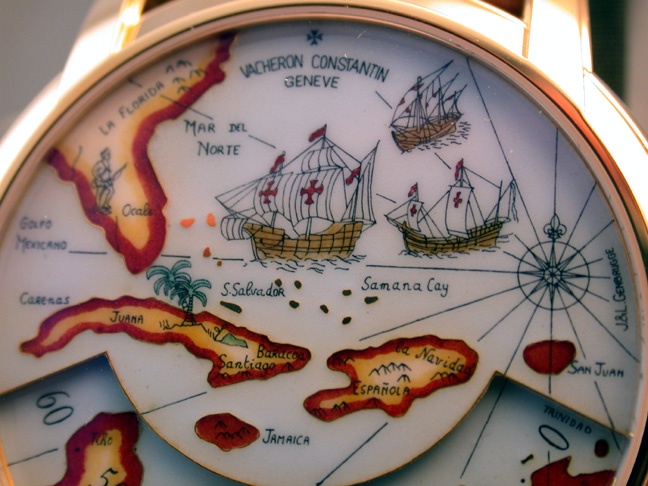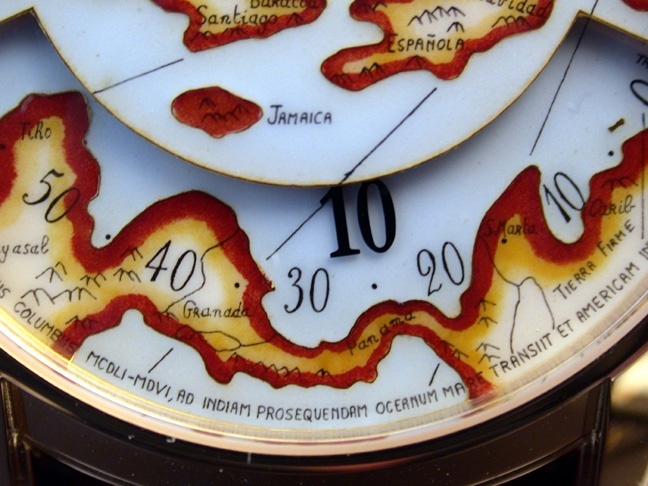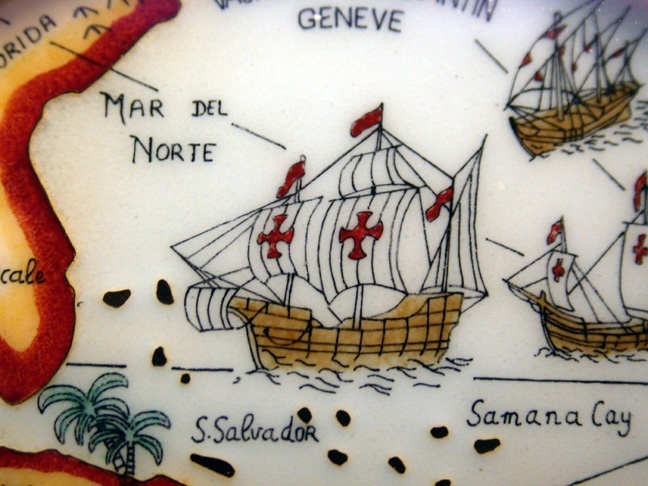Vacheron Constantin - MÉTIERS D'ART Tribute to Great Explorers "Christopher Colombus" Expedition
In 2004, when Vacheron Constantin inaugurated the limited series of watches created in honour of the great explorers, the Geneva-based brand was displaying a fierce determination to ensure the continuity of one of its most fundamental values: the workmanship traditions involved in fine watchmaking “metiers d’art” – or artistic crafts.
Clearly dedicated to excellence, Vacheron Constantin once again unveils two genuine works of art from both mechanical and aesthetic standpoints, thanks to a patented movement driving an astonishing reading of time and a dial sublimated by the extremely complex and time-honoured art of “grand feu” enamelling. An accomplishment worthy of those achieved by the great explorers of past centuries who, by risking their lives as they journeyed across land and sea, contributed to the advancement of Humankind.
Clearly dedicated to excellence, Vacheron Constantin once again unveils two genuine works of art from both mechanical and aesthetic standpoints, thanks to a patented movement driving an astonishing reading of time and a dial sublimated by the extremely complex and time-honoured art of “grand feu” enamelling. An accomplishment worthy of those achieved by the great explorers of past centuries who, by risking their lives as they journeyed across land and sea, contributed to the advancement of Humankind.
With the Tribute to the Great Explorers the cartographer gave way to the seafarers and heroes of the past who explored far and exotic lands. The dials remain in enamel but the time reading is done via rotating hour numerals.
Vacheron Constantin upped the dial difficulty in not only making it in champlevé enamel (once again supported to the dexterous hands of Jean and Lucie Genbrugge) but also having it stand on two levels, one overhanging the other. The upper part shows lands associated with the particular explorer’s exploits. The lower one is a 132° strip forming the dial’s bottom arc; it bears the minute track over which the rotating hour numeral travels clockwise in turn.
The enamelling technique used here is the champlevé one. The outline of the subject is first traced with a sharp metal point on a sheet of 22K gold barely half a millimeter thick and a little more than two dozen millimeters across. Under strong binocular magnification, using a paintbrush made of one or two marten hairs, a few droplets of enamel are deposited. Colors must imperatively be applied in a strict, predetermined order as to obtain the requested result.
That done, the workpiece is fired in a kiln at 700° - 800°C (1290° to 1470° F). After cooling, it is smoothed, in some cases with powdered corundum, and then meticulously polished. More enamel is then applied, fired, smoothed, polished and so on – up to thirty times per dial. Firing times must be calculated with great exactness according to the type and quantity of enamel applied, firing times are not rocket science and can vary between each work piece depending on the impressions of the enameller. At the end of this elaborate process, a coating of transparent flux is applied and the workpiece is fired yet again, this time to 900° C (1650° F). After cooling, the dial is smoothed and polished one last time.
This lengthy and meticulous procedure is hard on the nerves. Brittle and quirky, cooling enamel may unexpectedly shatter as it leaves the kiln. The heat-loss process must perforce be slow, careful and regular since sudden temperature changes can, in an instant, destroy countless hours of painstaking work.
This model’s two-part dial posed a further challenge inasmuch as to ensure a perfect match both parts had to be enamelled, fired and finished in tandem – doubling the risk!
The movement used in the TTGE is the tried and tested automatic cal 1126AT with an extra wandering hour module developed inhouse.
A Vacheron Constantin movement that makes time travel
Pushing their know-how to new frontiers of excellence, the engineers and watchmakers of the Manufacture have developed a complication which, thanks to the extreme reliability of the self-winding movement equipped with Vacheron Constantin Calibre 1126AT, sends time sailing in the cartographical wake of these intrepid adventurers.
At the heart of the watch lies a highly sophisticated and patented mechanism driving both parts of the dial thanks to a number of highly sophisticated devices linked by cams shaped like the brand-signature Maltese cross.
The dials represent the roads travelled and discovered by the chosen explorers. The first two dials were launched in 2004 and represented Zeng He and Magellan. Two new and final dials will be launched this year representing Marco Polo and Christopher Columbus. The Tribute to the Great Explorers even though not marketed as a limited edition will be made in only 60 pieces for each dial for a total of 240 all housed in a beautifully curvaceous yellow gold case. The case back is solid and engraved in a very à propos manner with a wind rose.
Return to story ....
FERNAND DE MAGELLAN (1480 - 1521): Patagonia
September 20, 1519. Commanding a fleet of five ships manned by 300 men, Fernand de Magellan sailed from the port of Seville, westward bound for the Spice Islands (today the Moluccas, part of Indonesia). Spurred by his studies and early experience, Magellan dreamed of reaching far-off Asia by sailing to the south of the landmass discovered by Christopher Colombus – no mean feat at the time. The ships reached Brazil, anchoring off what is today Rio de Janeiro, then travelled south to Patagonia. Surviving mutinies, quarrels, shipwrecks and disease, Magellan sailed on, buoyed by his enthusiasm and determination. He eventually discovered and navigated the straits that today bear his name, sailing along a coast dotted by native campsites which he called Tierra del Fuego (Land of Fire). He again reached the open sea, so marvelling at its calm expanses that he named it Pacific Ocean. Having reached the Philippines in 1521, he died during a battle with a local tribe. Only one of the five ships, with eighteen men and a hold full of spices, was to complete the journey back to Spain. It was the first vessel ever to have sailed all the way around the world. Over and above his dreams of exotic treasures, Magellan’s voyage demonstrated conclusively that the earth was indeed a sphere.
Thus steadily counting off the time, the hours journey to the far end of the upper dial facing its lower half, transforming the hour numeral into a symbolic hand specifying the number of minutes at a glance. The resulting magical dance of the hours is based on an ingenious configuration that called for a considerable amount of research and development.
This journey of time through time is a powerful metaphor of the long, difficult and often risky voyages undertaken by the great explorers in order to quench their thirst for discovery.
September 20, 1519. Commanding a fleet of five ships manned by 300 men, Fernand de Magellan sailed from the port of Seville, westward bound for the Spice Islands (today the Moluccas, part of Indonesia). Spurred by his studies and early experience, Magellan dreamed of reaching far-off Asia by sailing to the south of the landmass discovered by Christopher Colombus – no mean feat at the time. The ships reached Brazil, anchoring off what is today Rio de Janeiro, then travelled south to Patagonia. Surviving mutinies, quarrels, shipwrecks and disease, Magellan sailed on, buoyed by his enthusiasm and determination. He eventually discovered and navigated the straits that today bear his name, sailing along a coast dotted by native campsites which he called Tierra del Fuego (Land of Fire). He again reached the open sea, so marvelling at its calm expanses that he named it Pacific Ocean. Having reached the Philippines in 1521, he died during a battle with a local tribe. Only one of the five ships, with eighteen men and a hold full of spices, was to complete the journey back to Spain. It was the first vessel ever to have sailed all the way around the world. Over and above his dreams of exotic treasures, Magellan’s voyage demonstrated conclusively that the earth was indeed a sphere.
Let's go back to the clock ...
Pivoting crown, positioning fingerpieces, numeral-bearing rotating satellites: all these exclusive devices developed by the in-house engineers ensure an entirely original reading of time. The hour wheel features three arms extended by a satellite. Each carries four hour numerals, pointed in a direction determined by a Maltese cross-shaped cam. The hour crown turns in such a way as to line up the satellite bearing the appropriate hour number in front of the gap between the two parts of the dial. The Maltese cross-shaped cam then moves the appropriate number into the gap and the hour crown then makes it move from left to right in exactly one hour over the minute scale on the lower dial.Thus steadily counting off the time, the hours journey to the far end of the upper dial facing its lower half, transforming the hour numeral into a symbolic hand specifying the number of minutes at a glance. The resulting magical dance of the hours is based on an ingenious configuration that called for a considerable amount of research and development.
This journey of time through time is a powerful metaphor of the long, difficult and often risky voyages undertaken by the great explorers in order to quench their thirst for discovery.
The time-honoured art of “Grand feu” enamelling
The hour “crown” wheel’s three arms are each fitted with a satellite carrying four hour numerals whose position is controlled by a cam shaped like a Maltese cross. The “crown” wheel rotates so as to position in turn each of the satellites bearing the appropriate hour figure at the gap between the two parts of the dial. After the Maltese cross cam has caused the satellite to insert the correct hour figure in the dial gap, the hour “crown” wheel drives it clockwise during precisely one hour over the minute figures and guide marks inscribed on the lower part of the dial.
The hand-crafted nature of the task makes each execution and each dial a truly unique work of art.
But every sacrifice brings its reward and for the enameller, that means a creation literally bordering on perfection. Thus associated with the watchmaking art, this traditional craft reveals the full measure of its prodigious stature. The result is all the more striking, in that the detailed geographical depiction of the routes sailed by the great explorers is graced by superbly nuanced shades of colour ranging from the pale blue of the seas to the orangey ochre of dry land. A spectacular feat expressing a wealth of meticulous care.
---------------------------------
TECHNICAL DATA
Reference: 47070/000J-9085
Energy: automatic
Thickness (mm): 6.25
Diameter (mm): 32.80 (11''' ½)
Number of parts: 214
Number of jewels: 36
Frequency: 4 Hz (28'800 v.p.h.)
Power-reserve (hours): 38 approx.
Indication: hours, minutes
Size (mm): 40.00
Thickness (mm): 12.20
Shape: round
Water-resistance (bar): 3
OTHER Elements
Material of the dial: 22K gold
Strap: alligator Mississippiensis
Clasp: folding clasp
Specificity: Double "Grand Feu" enamelled dial
---------------------------------
TECHNICAL DATA
Reference: 47070/000J-9085
MOVEMENT
Reference: 1126 ATEnergy: automatic
Thickness (mm): 6.25
Diameter (mm): 32.80 (11''' ½)
Number of parts: 214
Number of jewels: 36
Frequency: 4 Hz (28'800 v.p.h.)
Power-reserve (hours): 38 approx.
Indication: hours, minutes
CASE
Material of the case: 18K 3N yellow goldSize (mm): 40.00
Thickness (mm): 12.20
Shape: round
Water-resistance (bar): 3
OTHER Elements
Material of the dial: 22K gold
Strap: alligator Mississippiensis
Clasp: folding clasp
Specificity: Double "Grand Feu" enamelled dial
Limited edition: 60 pieces
www.facebook.com - Vacheron Constantin
---------------------------------------------------------------------
www.Vacheron-Constantin.com




